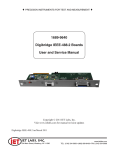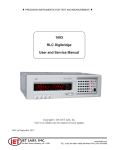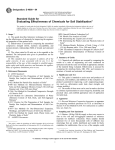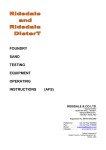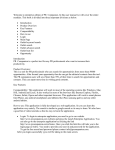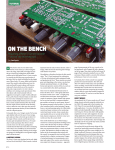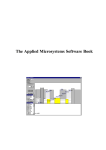Download DOD 1280 x 960 full real-time video & 8 million-pixel digital camera User guide
Transcript
- CX3 Digital Camera by Stuart K. Fairclough ‘The little camera that thinks it’s a big camera – and knows it!’ M any moons ago my Dad decided to take up photography as a hobby. He used to have many fads like this so I now know exactly where I get the innovative ideas and likewise fads from myself (bless him). Dad, being Dad, was not content with doing things by half measures; so he had to go all the way and do the photography bit but, also the developing and printing bit as well! Didn’t please my Mum much as the kitchen became the improvised dark-room and it all became a bit wordy, when Mum walked in on Dad as he was in the developing stage. Anyway, the camera he chose was a Zenith-E or Zenit, SLR camera. Great camera, don’t get me wrong but boy did you have to do a lot of fiddling with aperture, focus shutter settings etc., just to get a half reasonable photo. Then one day the likes of Ilford and/or Kodak (whichever came first), introduced the ‘instamatic’ camera and therefore ever after, a whole new breed of ‘point, click & shoot photo experts’ were born. M oving on a hundred years or so, someone came up with the bright idea of combining the idea of a ‘point & shoot compactability’ with modern digital technology and low and behold we now have out there, a positive plethora of compact digital cameras, with a variety of price ranges to match. Added to this equation of course, we now have just about every mobile coming with its own inbuilt digital camera. None of which impresses me, maybe because I prefer to use a mobile as a telephone rather than a mobile disco/camera or perhaps, I’m never any good at taking quick snaps with a mobile but, for me I prefer a thing that looks and feels like what it’s supposed to be and that is as a camera. Call me a cynic but it don’t matter how many mega-pixels it has got, I have yet to see a decent photograph that has been produced on a telephone. Here then, are some very good reasons for choosing a digital compact camera that sits above the parapet of just about every other model out there – namely, the Ricoh CX3 Digital Camera. I’ve left all of the specs of at the end of this review for the technically minded of you but here are some of my reasons why I think – rather know, that the Ricoh CX3 is in a class of its own. First thing is without doubt, the size or rather, lack of it, surely a camera this small cannot pack so much techy brilliant features? If you’re still into the more traditional feet and inches – in simple terms the Ricoh comes out at: just under 4”(W) x 2¼in (H) x 1in (D) with the lens fully closed and 2¼in (D) with the lens fully extended. The LCD picture display screen comes out at a very viewable 23/8in x 1 7/8in. Compact does not however, mean fiddly, all the operating function buttons and controls are well spaced and not at all fiddly to adjust even with my jumbo fingers. 1 From this diagram (fig1) and the reference table (fig2), you can see a complete breakdown of all of the functions. In (fig3) you can see the various functions on the Mode Dial. (fig1) (fig3) 1 2 3 4 5 6 7 8 9 10 11 12 13 14 15 16 17 Picture Display Strap Eyelet Terminal Cover Speaker (fig2) USB Terminal AV Output Terminal Macro ADJ/OK Button (Flash) (Playback) Button MENU Button Function Button Self-timer/ (Delete) Button DISP. Button Power (DC input) Cable Cover Battery/Card Cover Tripod Screw Hole For the less technically minded or rather, for those of you who just want to be able to take the best pictures possible in most conditions, setting the mode dial to Auto Shooting (Focus & Shoot), will best suit just about most peoples needs. In this mode the camera does exactly that and will set everything automatically for you so all you have to worry about is exactly getting perfect shot, just at the right moment. Other settings include: Scene Auto ModeI. In this mode the camera will set itself to take the best optimal picture from on eof 13 subject types. These subject types range from Portrait; Sports; Pets; Nightscape; Landcsape and a whole host of other types. In Movie Mode you can shoot up to 29 minutes of live action with sound at a reasonable 30fps. One particular setting which I thought was really innovative and technically a brilliant concept, was the Dynamic Range mode. The "dynamic range" refers to the range of brightness that can be processed by the camera. When you set the mode dial to and shoot, the scene is reproduced with a smooth transition from the bright areas to the dark areas, allowing you to capture a more natural-looking image. Here is an example of the effect of Dynamic Range showing a sort of before and after effect: 2 Here’s a couple more demo examples of just what can be achieved when using the Ricoh CX3 when using different modes. In all fairness reproduced photos here is not a really true representation of the quality of what the Ricoh is capable of producing. As a sort of experiment however, I took two photos of my dog Trudy, one with the Ricoh and one using a different digital compact camera and here are the results: Both shots were taken using full Auto mode. Now whether perhaps because I’ve got a bit of a shaky hand or not but clearly the photo on the far left taken with the Ricoh is not only considerably sharper but also much richer in tone and colour. Incidentally, I chose Trudy as my subject not just because she’s just gorgeous but also because she simply never keeps still for a second and I thought that this was a great way of showing off just one of the Ricoh’s best attributes, in particular the attributes of its ant-shake system which are clearly evident. In the second photo taken with another digital camera, even though she appears to be resting on her cushion, she was continually shifting around and therefore trying to frame her added to the test shot. T he Ricoh comes with a drivers CD and a USB/PC connecting cable which when connected will link you directly to your PC or compatible printer. The CX3 User guide packed a whopping 136 pages of information although it was a bit too compact in size for me. Going onto the Ricoh web site at www.ricoh.com will give you access to all the available manuals and software updates and of course the all-important Support section if you needed it. The Ricoh CX3 also comes with its own small charging unit and mains lead for charging the battery and a phono/audio lead. Memory-wise: without adding one of them SD memory card thingy’s, you can store on the Ricoh (so they say), in the region of 402 to 705 pictures (I did find that with the Ricoh set to the highest mode the number of photos that could actually be saved to the internal memory was somewhat less than these quoted figures) . A 1gb card will allow you to store over a 1,000 photos and if you went really big and installed the massive 32gb SD card, you can store something like 35,000+ photos. I would say that it would also be best to invest in an SD memory card, apart from anything else it gives you that little extra safe guard and additionally proves you with that extra simplicity and portability factor. Price-wise, I found the best price on-line was around £224 with free delivery and even at that price I think that you should expect something exceptional and with the Ricoh CX3 you do. As the old adage says: ‘You gets what you pay for…’. More importantly however with a brand name as unique as Ricoh, you know you’re going to get the best for your money with a quality to match. Yes there are cheaper compact digital cameras out there but not, I would suggest with the same level of technical quality to match. 3 T he Ricoh was an absolute doddle to use and it was great fun experimenting with the different settings but for me, most of the time I just wanted to be able to take a half decent photo painlessly and effortlessly and know that when I review the photo I can feel confident that I am going to get just that. In fact the reality exceeded my expectations. I’m also a terror for not reading manuals before I play with the hardware, I like to see just how easy a thing is to operate. Ease of operation being the operative phrase here, I found the camera just about as easy to use, straight from the box as it could be. Literally within less than a minute, I was reviewing an array of random snaps I had just taken. I f you are looking for an all-round, quality compact digital camera but with the capabilities of matching most currently available high priced SLR cameras, then look no further than the Ricoh CX3. Even better, put it on your Xmas wish list and perhaps drop a hint to the other half and see what you get? For a much greater in depth look at the Ricoh CX3, click on the link here and download the full Manual in PDF format: http://www.ricoh.com/r_dc/support/manual/pdf/cx3/CX3_E.pdf Here now is all that technical stuff that you’ve just been dying to get to… Ricoh announces the CX3 28-300 mm High-Magnification Wide-Angle Digital Camera with a Back-Illuminated CMOS Image Sensor for Greater Sensitivity Tokyo, Japan, February 3, 2010—Ricoh Co., Ltd. (president and CEO: Shiro Kondo) announced the development and release of the CX3, a new digital camera featuring a high magnification 10.7x (28-300 mm) optical wide-angle zoom lens, a back-illuminated CMOS sensor, and an enhanced noise reduction function. With a back-illuminated CMOS sensor and a noise reduction function incorporating the algorithm used on the GR DIGITAL III (introduced August 2009), the new CX3 has dramatically improved image quality performance when shooting low-light scenes. When the camera is pointed at the subject, the new "scene auto mode" will switch to the optimum scene mode. Since the camera automatically changes to the optimum shooting settings, you can enjoy easy shooting of beautiful photographs. 4 Shooting has never been more enjoyable. With many other function enhancements, such as the addition of a 1280 × 720 pixel HD movie function, the addition of high & low luminance priority settings for "dynamic range double shot mode" dynamic range expansion effects, and the addition of the "pets" scene mode. The CX3 compact digital camera takes another step forward in realizing the Ricoh design concept "A tool you will want to use every day." Main features of the new CX3 1. Greater image quality in low-light scenes possible with a back-illuminated CMOS sensor and a new noise reduction function ・ The back-illuminated 10 megapixel CMOS sensor significantly increases shooting performance in lowlight scenes. ・ The CX3 uses the noise reduction algorithm introduced on the GR DIGITAL III. Performing noise reduction processing on the signal immediately after it is output by the CMOS sensor makes it possible to reduce noise while maintaining resolution, tone characteristics, and saturation. ・ The noise reduction level can be specified as Off, Auto, Weak, Strong, or MAX. By specifying MAX, it is possible to do sophisticated variance-estimation type noise reduction processing in which the sensor image data's noise variance is analysed and the optimum processing is done for each region. 2. The 28-300 mm 10.7x optical zoom is mounted on a body that is both easy to operate and easy to carry ・ Ricoh's original retracting lens system made it possible to fit the high magnification 10.7x optical wideangle zoom lens in a compact 29.4 mm body. ・ With 28 mm wide-angle to 300 mm telephoto coverage, this high magnification zoom lens can handle a wide range of shooting situations, including powerful telephoto shots as well as wide-angle shooting of both expansive landscapes and interior scenes with limited distance between camera and subject. 3. By just pointing the camera at the subject, "scene auto mode" will switch to the optimum shooting settings ・ With "scene auto mode," the camera identifies the type of scene being photographed (portrait, sports, night portrait, landscape, nightscape, macro mode, etc.) and automatically switches to the optimum shooting settings. Enjoy quick and easy photography of people, landscapes, nightscapes, close-ups, and much else. 4. Get the shot you want with high-speed continuous shooting functions capable of high image quality ・ It is possible to do high-speed continuous shooting at approximately 5 frames/second for still images with the maximum number of pixels. * Continuous shooting speed will vary depending on shooting conditions, card type, card condition, etc. ・ For the M-continuous plus shooting function, which saves consecutive images shot before the finger is removed from the shutter release button, there is a mode that makes it possible to shoot at the maximum number of pixels. To fit the scene being photographed, you can select from two modes: MContinuous Plus (10M) for 15 images taken in as little as three seconds and M-Continuous Plus (2M) 5 for 26 images taken in about 0.9 seconds. * M-Continuous Plus (10M) image size is fixed at 10M 4:3N. * M-Continuous Plus (2M) image size is fixed at 2M 4:3N. * The consecutively shot images are recorded as a single MP file (a file format with multiple still images in a single file). ・ With ultra-high-speed continuous shooting, the CX3 shoots 120 images (120 frames/sec.) during an interval of about one second after the shutter release button is pushed, or 120 images (60 frames/sec.) during an interval of about two seconds. * Image size is fixed at VGA 4:3N. * The consecutively shot images are recorded as a single MP file (a file format with multiple still images in a single file). 5. High image quality that will expand your range of expression ・ Dynamic range double shot mode makes it possible to record images with an almost naked-eye impression, and new detailed settings have been added to control the dynamic range expansion effect. It is now possible to choose the tone range to be given priority using the following options: highlights, shadows, and off. ・ Residing on a customized circuit of the image processing engine Smooth Imaging Engine IV, the pixel output interpolation algorithm reduces whiteout in high-contrast situations, thereby recreating beauty as seen. ・ Multi-pattern auto white balance makes it possible to recreate natural as-seen colours even in peoplephotography scenes that were difficult to shoot with past auto white balance functions, such as scenes with both shadow and sunlight and scenes mixing flash and natural light (or fluorescent light, etc.). 6. New modes to stimulate creative photography. ・ The new "pets mode" turns off the flash, AF auxiliary light, and operation sounds to avoid startling the pet. You can easily capture the antics of your cute pet. This mode also gives priority in focusing for a cat's face when one is detected. ・ The 13 scene modes includes two popular modes introduced on the CX2: "miniaturize mode" makes it possible to shoot actual scenes but record images that recreate the impression given when photographing miniatures; "high-contrast B&W mode" makes it possible to record images with a grainy feel such as that created by using ultra-high-sensitivity film in a film camera or by push processing film at the development stage. 7. High-definition 3.0-inch 920,000-dot VGA LCD monitor. ・ The large, high-resolution LCD monitor has a wide viewing angle and high contrast. The screen has a fluorine coat to prevent soiling, a hard coat to prevent scratches, and an anti-reflection coat to give excellent visibility even outdoors in bright sunshine. ・ With sRGB comparison of 100% for colour reproduction range, the monitor vividly reproduces image colours. 8. A wide range of functions inspired by the "A tool you will want to use every day" concept. ・ It is now possible to shoot 1280 × 720 pixel HD movies. 6 ・ With the macro photography functions you can get as close to the subject as 1 cm for wide angle* and 28 cm for telephoto. *Equivalent to 31 mm focal length for 35 mm cameras ・ There is a function for shooting aspect ratio 16:9 still images. ・ In playback, it is now possible to display images in date of recording sequence. The CX3 SRP £299.99 inc. CX3 – Specifications: Items Specifications No. of Effective Pixels (Camera) Approximately 10.00 million pixels Image Sensor 1/2.3-inch CMOS (total pixels: approx. 10.60 million pixels) Lens Focal length f=4.9-52.5mm (Equivalent to 28-300 mm for 35 mm film cameras. With Step Zoom set, focal lengths can be fixed at eight steps: 28 mm, 35 mm, 50 mm, 85 mm, 105 mm, 135 mm, 200 mm, and 300 mm) F-aperture F3.5 (Wide) - F5.6 (Telephoto) Shooting Distance Normal shooting: Approx. 30 cm - infinity (Wide), approx. 1.5 m - infinity (Telephoto) (from the front of the lens) Macro: Approx. 1 cm - infinity (Wide), approx. 28 cm - infinity (Telephoto), approx. 1 cm - infinity (Zoom Macro) (from the front of the lens) Lens Construction 10 elements in 7 groups (aspheric lens: 4 elements and 5 surfaces) Zoom Magnification Optical: 10.7x zoom (equivalent to 28-300 mm focal length for 35 mm cameras) Digital: 4.8x up to 51.4x (equivalent to 1440 mm) when used with optical zoom *1 *1 Auto Resize: 5.7x up to 61.0x (equivalent to 1710 mm) when used with optical zoom Focus Mode Multi AF (contrast AF method) / Spot AF (contrast AF method) / Face-Priority AF / Continuous AF / Multi-target AF / MF / Snap / ∞ (with AF Auxiliary Light) Motion Blur Reduction Image sensor shift method image stabilizer Shutter Speed *2 Continuous Shooting Exposure Control ISO Sensitivity Sensitivity) Still image 8, 4, 2, 1 - 1/2000 sec. Movie 1/30 - 1/2000 sec. Continuous shooting *3 speed approx.5 frames/sec. (10M 4:3F shooting time; shooting speed after 12 pictures is approx. 3 frames/sec.) Continuous shooting capacity 999 pictures Exposure Metering Mode Multi Light Metering (256 segments) / Centre-weighted Light Metering / Spot Metering Exposure Mode Program AE Exposure Compensation Manual Exposure Compensation +/-2.0EV (1/3EV Steps), Auto Bracket Function (-0.5EV, ±0, +0.5EV) (Standard White Balance Mode Output AUTO, ISO80 / ISO100 / ISO200 / ISO400 / ISO800 / ISO1600 / ISO3200 Auto / Multi-pattern Auto / Outdoors / Cloudy / Incandescent Lamp / Incandescent Lamp 2 / Fluorescent Lamp / Manual Settings, White balance bracket function 7 Flash Flash Mode Built-in range Auto flash (fires automatically in low-light conditions and when the subject is backlit) / Red-eye Flash / Flash On / Flash Synchro. / Flash Off flash Approx. 20 cm - 4.0 m (Wide), approx. 28 cm - 4.0 m (Telephoto) (ISO Auto/ISO Auto Maximum 1600, from the front of the lens) Flash compensation +/-2.0EV (1/3EV Steps) Monitor 3.0-inch Transparent LCD (approx. 920,000 dots) Shooting Mode Auto shooting mode / Scene auto mode / Dynamic range double shot mode / Continuous mode / Scene mode (Portrait / Sports / Pets / Night. Port. / Nightscape / Miniaturize / Landscape / High Sens / High Contrast B&W / Discreet Mode / Zoom Macro / Text Mode / Skew Correct Mode) / My settings mode / Movie mode Picture Quality Mode F (Fine) / N (Normal) Storage Capacity Internal Memory Approx. 88mb No. of Pixels Recorded Still image/multipicture Movie *5 Text Recording Media Recording File Format 3648 x 2736, 3648 x 2432, 2736 x 2736, 3648 x 2048, 2592 x 1944, 2048 x 1536, 1728 x 1296 (multi-picture only), 1280 x 960, 640 x 480 1280 x 720, 640 x 480, 320 x 240 3648 x 2736, 2048 x 1536 SD memory card SDHC memory card (up to 32 GB), Internal memory (approx. 88 MB) Still Image JPEG(Exif ver.2.21) Multi-picture CIPA DC-007-2009 Multi-Picture Format Movie AVI (Open DML Motion JPEG Format compliant) Compression method JPEG Baseline method compliant Other Major Shooting Functions Continuous, Self-Timer (operation time: approx. 10 sec. / approx. 2 sec. / custom self-timer), Interval Timer (Shooting interval: 5 sec. - 1 hour (5 sec. steps), Colour Bracket function, Focus Bracket function, AE/AF Target Shift, Histogram, Grid Guide, Electronic Level Storage Capacity Movie 1280 x 720 (17 sec.), 640 x 480 (50 sec.), 320 × 240 (2 min. 1 sec.) Other Major Playback Functions Grid View, Enlarged Display (maximum 16x), Resize, Level Compensation, White Balance Compensation, Trim, Flag, Slideshow, DPOF Setting Interface USB 2.0 (High-Speed USB) Mini-B, Mass storage compatible / AV Out 1.0Vp-p (75Ω) Video Signal Format NTSC, PAL switchable *7 Power Supply Battery Consumption Rechargeable Battery: DB-100 x1 *8 Based on CIPA Standard: Using the DB-100, approx. 310 pictures (when LCD *9 Dim is on) External Dimensions 101.5 mm (W) x 58.3 mm (H) x 29.4 mm (D) (according to CIPA guidelines) Weight Approx. 206 g (including the supplied battery and SD memory card) Approx. 185 g (body only) Operating Temperature Range 0°C - 40°C 8








